题目内容
短文改错
文中共有10处语言错误,每句中最多有两处。每处错误仅涉及一个单词的增加、删除或修改。
增加:在缺词处加一个漏字符(∧),并在其下面写出该加的词。
删除:把多余的词用斜线(\)划掉。
修改:在错的词下划一横线,并在该词下面写出修改后的词。
注意: 1. 每处错误及其修改均仅限一词;
2. 只允许修改10处,多者(从第11处起)不计分。
Long ago, an Ojibway Indian naming Wenibojo went on a long trip to the forest. When he got hunger, he dug up the roots of a bush and ate them. The roots were tasted good, but they made him sick. Wenibojo looked for everything better to eat. Suddenly he heard the sounds of ducks nearby. He followed the sounds from a beautiful lake, which the ducks were eating plants. Wenibojo tasted one. To his surprise, it was wild rice! He returned his village to tell the people there about the special food. Nowadays, the Ojibways still harvests rice, but only as many as they need. They always left some rice on the farm so that the ducks can eat.
 口算题卡北京妇女儿童出版社系列答案
口算题卡北京妇女儿童出版社系列答案
